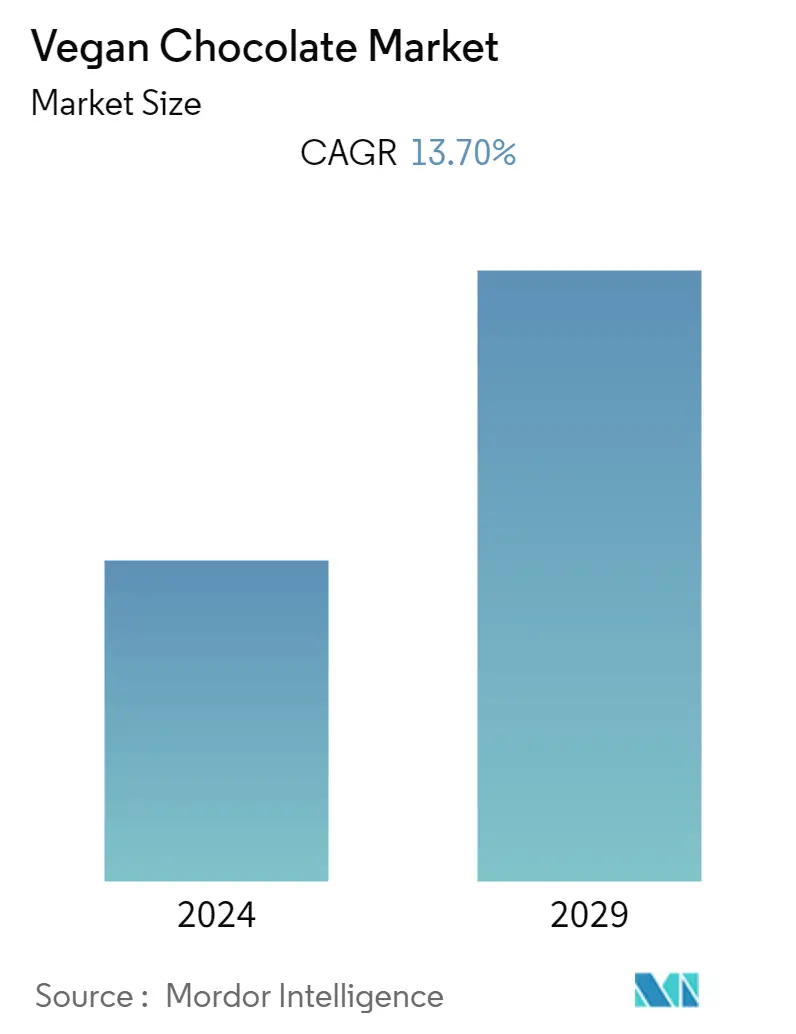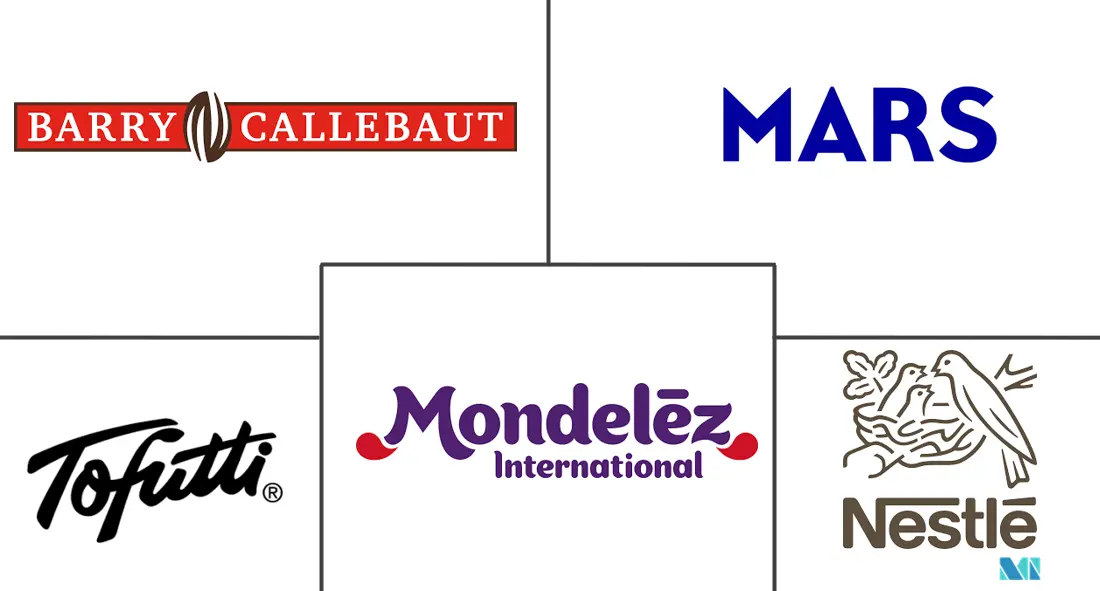Market Size of Vegan Chocolate Industry

| Study Period | 2019 - 2029 |
| Base Year For Estimation | 2023 |
| Forecast Data Period | 2024 - 2029 |
| CAGR | 13.70 % |
| Fastest Growing Market | Asia-Pacific |
| Largest Market | Europe |
| Market Concentration | Low |
Major Players
*Disclaimer: Major Players sorted in no particular order |
Vegan Chocolate Market Analysis
Global Vegan Chocolate Market is projected to register a CAGR of 13.7% during the forecast period (2022-2027).
The growing popularity of veganism among consumers across the globe, especially among millennials is a major factor driving the growth of the market. For instance, according to the vegan society, in 2014, the number of vegans in Great Britain was estimated to be 150 thousand, which increased to 600 thousand in 2019. An increasing number of environmental protection campaigns and growing awareness about animal cruelty are supporting the growth of the market. In recent years, consumers' food tastes have also changed as a result of rising food allergies and cases of lactose intolerance in both children and adults. For instance, the Food Tolerance Network reported that in 2019, almost 70% of people worldwide are lactose intolerant.
Some vegan chocolate brands also use milk substitutes like almond milk or soy milk to produce authentic vegan chocolates. For instance, in 2021, an Indian brand 'MilkinOats' has launched vegan milk chocolate made with oat milk. Their premium range, called Chalet Chokolad, is made in Swiss chalets and offers two varieties namely Chalet Velvety and Chalet Almond Crunch. Moreover, factors like concerns regarding animals' welfare in food production, the belief that vegan chocolates are healthier that boost healthy blood sugar, and the usage of alternative sweeteners like stevia in manufacturing processes are expected to boost the market at a faster pace during the forecast period.
Vegan Chocolate Industry Segmentation
Vegan chocolates are made with plant-based ingredients such as cacao beans, soy milk, and maple syrup without adding any animal-related products like dairy products. The global vegan chocolate market is segmented by chocolate type, product type, distribution channel, and geography. By chocolate type, the market is segmented into milk chocolate & white chocolate, and dark chocolate. Based on the distribution channel, the market is segmented into supermarkets/hypermarkets, convenience stores, online retail stores, and other distribution channels. It provides an analysis of emerging and established economies across the world, comprising North America, Europe, South America, Asia-Pacific, and Middle-East & Africa. For each segment, the market sizing and forecasts have been done on the basis of value (in USD million).
| By Chocolate Type | |
| Milk Chocolate & White Chocolate | |
| Dark Chocolate | |
| Other Types |
| By Product Type | |
| Boxed Assortments | |
| Countlines | |
| Others |
| By Distibution Channel | |
| Supermarkets/Hypermarkets | |
| Convenience stores | |
| Online Stores | |
| Other Distribution Channels |
| By Geography | |||||||||
| |||||||||
| |||||||||
| |||||||||
| |||||||||
|
Vegan Chocolate Market Size Summary
The vegan chocolate market is experiencing robust growth, driven by the increasing popularity of veganism, particularly among millennials, and heightened awareness of environmental and animal welfare issues. This shift in consumer preferences is further supported by rising food allergies and lactose intolerance, prompting a demand for dairy-free alternatives. Brands are innovating by using substitutes like almond and oat milk to create authentic vegan chocolates, appealing to health-conscious consumers who prioritize nutritious and sustainable food choices. The market is also benefiting from the perception that vegan chocolates offer health advantages, such as improved blood sugar levels and antioxidant properties, attracting a broader audience seeking healthier lifestyle options.
In Europe, the vegan chocolate market is witnessing significant expansion due to the region's growing acceptance of vegan and flexitarian diets. The demand is further bolstered by cultural events like Easter, where vegan chocolates are increasingly favored as gifts. This trend has prompted manufacturers to introduce vegan-friendly products, such as Lindt's dark chocolate gold rabbit and Divine's vegan dark chocolate egg. The market is characterized by a mix of established and emerging players, with companies investing in research and development to introduce innovative flavors and enhance their product offerings. Key industry players, including Mars, Incorporated, Mondelēz International, and Nestle SA, are actively expanding their vegan chocolate lines to capture the growing consumer interest in plant-based diets.
Vegan Chocolate Market Size - Table of Contents
-
1. MARKET DYNAMICS
-
1.1 Market Drivers
-
1.2 Market Restraints
-
1.3 Porter's Five Force Analysis
-
1.3.1 Threat of New Entrants
-
1.3.2 Bargaining Power of Buyers/Consumers
-
1.3.3 Bargaining Power of Suppliers
-
1.3.4 Threat of Substitute Products
-
1.3.5 Intensity of Competitive Rivalry
-
-
-
2. MARKET SEGMENTATION
-
2.1 By Chocolate Type
-
2.1.1 Milk Chocolate & White Chocolate
-
2.1.2 Dark Chocolate
-
2.1.3 Other Types
-
-
2.2 By Product Type
-
2.2.1 Boxed Assortments
-
2.2.2 Countlines
-
2.2.3 Others
-
-
2.3 By Distibution Channel
-
2.3.1 Supermarkets/Hypermarkets
-
2.3.2 Convenience stores
-
2.3.3 Online Stores
-
2.3.4 Other Distribution Channels
-
-
2.4 By Geography
-
2.4.1 North America
-
2.4.1.1 United States
-
2.4.1.2 Canada
-
2.4.1.3 Mexico
-
2.4.1.4 Rest of North America
-
-
2.4.2 Europe
-
2.4.2.1 United Kingdom
-
2.4.2.2 Germany
-
2.4.2.3 Spain
-
2.4.2.4 France
-
2.4.2.5 Italy
-
2.4.2.6 Russia
-
2.4.2.7 Rest of Europe
-
-
2.4.3 Asia-Pacific
-
2.4.3.1 China
-
2.4.3.2 Japan
-
2.4.3.3 India
-
2.4.3.4 Australia
-
2.4.3.5 Rest of Asia-Pacific
-
-
2.4.4 South America
-
2.4.4.1 Brazil
-
2.4.4.2 Argentina
-
2.4.4.3 Rest of South America
-
-
2.4.5 Middle East & Africa
-
2.4.5.1 Saudi Arabia
-
2.4.5.2 South Africa
-
2.4.5.3 Rest of Middle East & Africa
-
-
-
Vegan Chocolate Market Size FAQs
What is the current Vegan Chocolate Market size?
The Vegan Chocolate Market is projected to register a CAGR of 13.7% during the forecast period (2025-2030)
Who are the key players in Vegan Chocolate Market?
Barry Callebaut, Tofutti Brands, Inc., Mondelēz International., Nestle SA and Mars, Incorporated are the major companies operating in the Vegan Chocolate Market.

